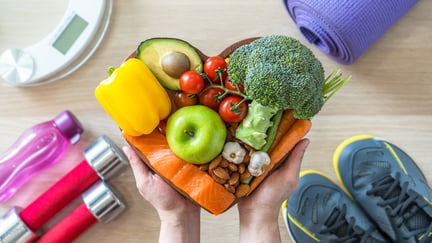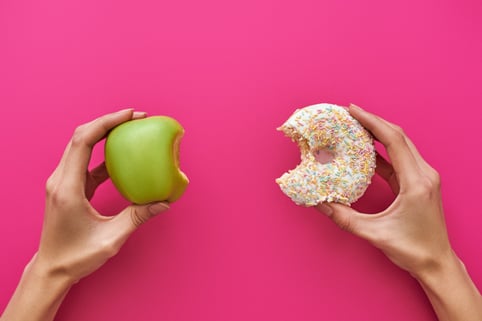 With inflation at a 40 year high and grocery costs up close to 11% when
With inflation at a 40 year high and grocery costs up close to 11% when
compared to 2021, saving money at the store has become a priority for many. However, when trying to save money at the store, many individuals cut back on the pricier yet healthier items, such as fruits, vegetables, and lean protein sources, even though it’s not necessary! Here are some tips and tricks for maintaining a healthy diet while shopping smart and saving money at the store:
1. Have a grocery store game plan. Make a list of the meals and snacks you plan
to eat throughout the week and the foods you will need to make them. Sticking to
this list will help prevent you from buying things you do not need, which often
results in wasted food and money.
2. Join your store's loyalty or rewards program. Often, these programs are free
and automatically apply savings at checkout, requiring minimal effort from the
consumer!
3. Buy “in-season” and/or “local” fruits and vegetables when possible. Fruits
and vegetables that are local and/or in season are typically cheaper to produce
and ship, resulting in a lower price for the consumer compared to
exotic/hard-to-find or out-of-season produce. Use this link to see what produce is
currently in season!
4. If you have freezer space available, purchase frozen fruits and vegetables
without added salt or sauces. Typically frozen fruits and vegetables are just as
healthy and are a fraction of the cost when compared to those that are fresh.
5. Buy canned fruits and vegetables. When purchasing fruits, try to buy those
that are packaged in 100% fruit juice. When purchasing vegetables, look for
those that have “no salt added” listed on the label, or simply rinse prior to
preparing/cooking to help wash off some of the salt added for preservation.
6. Grow your own! Grow your own fruits, vegetables, and herbs to cut back on
packaging costs.
7. Check the “sell by” or “best by” date to ensure you are buying the freshest
items.
8. Compare your options. Compare and contrast different sizes and brands to find
the most cost-effective option. Looking at the “price per unit” can help you find
the best deal!
When you know a certain food or drink will get used, buy in bulk or
purchase value- or family-sized items. For produce and meat, anything that isn’t
used can be frozen for later use.


 Fueling your body before and after exercise is essential for ensuring you will have enough energy to both perform and recover. However, it is important to choose the right foods, and to consume them at the appropriate time, to optimize your nutrition. What and when you eat varies depending on the individual and their preferences, the type of activity being performed, and whether the food is being consumed before or after physical activity.
Fueling your body before and after exercise is essential for ensuring you will have enough energy to both perform and recover. However, it is important to choose the right foods, and to consume them at the appropriate time, to optimize your nutrition. What and when you eat varies depending on the individual and their preferences, the type of activity being performed, and whether the food is being consumed before or after physical activity. Wash your hands.
Wash your hands.
 Did you know federal law doesn’t require the potency, purity, efficacy, or safety of dietary supplements to be proven prior to being put on the market? In fact, most dietary supplements are already being sold before the Food and Drug Administration’s safety monitoring role begins. This means you could be taking a supplement that doesn’t even contain what is listed on the label, or that contains significantly different amounts than it claims to contain. This is concerning, as data from the National Health and Nutrition Examination Survey conducted in 2017-2018 revealed that close to 60% of U.S. adults reported taking a dietary supplement within the last 30 days, and this percentage is predicted to be on the rise.
Did you know federal law doesn’t require the potency, purity, efficacy, or safety of dietary supplements to be proven prior to being put on the market? In fact, most dietary supplements are already being sold before the Food and Drug Administration’s safety monitoring role begins. This means you could be taking a supplement that doesn’t even contain what is listed on the label, or that contains significantly different amounts than it claims to contain. This is concerning, as data from the National Health and Nutrition Examination Survey conducted in 2017-2018 revealed that close to 60% of U.S. adults reported taking a dietary supplement within the last 30 days, and this percentage is predicted to be on the rise. There is a very clear, well understood relationship between food and physical health, but
There is a very clear, well understood relationship between food and physical health, but
 At some point in our busy lives we eat a quick meal, or get so busy we forget to eat. Our jobs can leave us working while eating lunch, not truly taking the time to sit for the meal. Check out these four "not-so-healthy" habits and how you can work to fix them to avoid overeating during your meals.
At some point in our busy lives we eat a quick meal, or get so busy we forget to eat. Our jobs can leave us working while eating lunch, not truly taking the time to sit for the meal. Check out these four "not-so-healthy" habits and how you can work to fix them to avoid overeating during your meals.  Eating out at restaurants or on the go doesn’t have to break the calorie bank or bust your diet. Here are some tips and tricks for keeping your order healthy when eating out:
Eating out at restaurants or on the go doesn’t have to break the calorie bank or bust your diet. Here are some tips and tricks for keeping your order healthy when eating out:.jpg?width=437&name=GettyImages-1279631867%20(1).jpg) When it come to health, certain fats can have a positive effect, whereas other can negatively impact your health. All fats are equal from a caloric standpoint meaning they all contain 9 calories per each gram of fat no matter the type. There are 3 main types of fat - saturated fats, monounsaturated fats, and polyunsaturated fats. The 2020-2025 Dietary Guidelines for Americans recommend that the
When it come to health, certain fats can have a positive effect, whereas other can negatively impact your health. All fats are equal from a caloric standpoint meaning they all contain 9 calories per each gram of fat no matter the type. There are 3 main types of fat - saturated fats, monounsaturated fats, and polyunsaturated fats. The 2020-2025 Dietary Guidelines for Americans recommend that the
 We are on the brink of a New Year and those looming resolutions start filling our head with what we should do or consider changing. Keep a positive mindset to not allow resolutions to fall to the wayside in the New Year, allow them to become lifestyle changes. Know that when you fall short, it's ok to give your self a restart. Check out these nine nutrition-related New Year's resolutions to not only set, but stick to.
We are on the brink of a New Year and those looming resolutions start filling our head with what we should do or consider changing. Keep a positive mindset to not allow resolutions to fall to the wayside in the New Year, allow them to become lifestyle changes. Know that when you fall short, it's ok to give your self a restart. Check out these nine nutrition-related New Year's resolutions to not only set, but stick to. 